
Getting Started
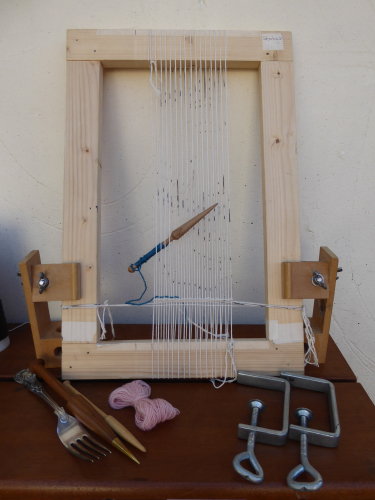 Basic tools for tapestry weaving
Basic tools for tapestry weavingTapestry weaving need not be an expensive hobby to start with. If you are just starting tapestry weaving, here is some initial guidance.
Warp
Warps are the vertical threads that are the foundation of tapestry and what you will use to weave over. The most common warp is cabled cotton which is made up of single cotton strands which are plied and so can remain strong whilst under tension. This is available from specialist suppliers and it is strongly recommended that you invest in some: it might look expensive but will probably last you for years.
Warp comes in different thicknesses, depending on what you are weaving, so trying a mid-range size will give you an idea of what is possible.
Amongst other materials you can use for warps are string, crochet cotton or fishing line and many tapestry weavers use but be aware that they may stretch or break so are not always suitable for a beginner.
Weft
Weft is the yarn (although it need not always be yarn!) that is used to go over and under the weft and, although the warp is sometimes deliberately left visible, the weft is usually the area that is seen.
You will need something to weave with. Experimenting with different types of yarn will give you an idea of how they behave and the effects they give so try knitting, crochet or paper yarn, embroidery threads, garden string – in fact anything you have in your stash.
For a beginner, wool is ideal as it has some ‘give’ in it: cotton and linen are not as easy to use as they have less stretch. Needlepoint or crewel wool is designed not to pull apart and can often be found in charity shops: knitting wool may compress down quite a lot but has the attraction of being easily available with a range of colours and effects.
Worsted wool is the material of choice for most weavers: it is a high twist yarn with little elasticity and specialist suppliers can provide a range of yarn thicknesses, colours and quantities.
As a beginner, you are in an ideal position to experiment with all these different materials so just play!
For more technical information on warp and weft materials, weaversbazaar have excellent information in their Knowledge Zone.
What to weave on?
Tapestry needs a strong support for the warps: something which will keep them under tension without breaking.
Looms are discussed in another information sheet, but you can weave on a cardboard frame, a picture frame, a purpose built and tensioned loom or even a branch.
Using images
Many weavers design their own images, but if you prefer to copy an image then please be aware of copyright issues. It is generally okay to take a basic idea and run with it but ensure that it is your own and not an identical image. If you have been inspired by another artist, why not acknowledge it?
Most weavers will use a ‘cartoon’ where the image is drawn on to paper and either drawn on or attached to the warps.
The traditional way is to mark each warp where your cartoon lines are: use a permanent marker (otherwise you’ll end up with messy fingers) and mark all the way around each warp as the warps may move as you weave and you’ll miss an important line.
If you prefer to attach your cartoon to the warps, sew the cartoon at the bottom of the warps, and consider using magnets to keep the cartoon close to the warps as you weave your way up. Rare Earth magnets are extremely strong but keep them away from small fingers and your mouth.
Whichever technique you use, keep your cartoon simple, otherwise you may get confused with all the lines!
Equipment
Apart from a loom and yarn, you need little else. However, as you become more interested in tapestry weaving, here are some things you might find useful.
Needle:
Many weavers ‘pick’ the warps, using their fingers but depending on how finely you weave, you may find a needle easier – these can be a conventional needle, wooden or plastic. Look for a blunt needle with a big eye.
Beater:
Beating down the weft can help to cover the warps, even out a line of weaving and give a firmer feel to the tapestry. Beaters can be purchased but a fork willdo the job just as well. For a weighted fork, attach something heavy to the fork on the flat area just before the tines.
Butterflies:
You might just think it easier to just pass the yarn between the warps as if you are sewing, but if you have long lengths of yarn you may find the weft starting to fray as it passes between the warps. There are two options: butterflies or bobbins.
Butterflies are lengths of weft wound around the fingers and tied. As you weave, you pull out enough yarn from the butterfly to use, protecting the remainder of the bundle.
Bobbins:
Bobbins are what everyone associates with weaving and they have an undeniable charm. They are available in plastic or wood: wooden ones are an investment but reusable, and you will need quite a few, depending on the size or complexity of your tapestry. The weft is wound around the bobbin and the thick (never the pointed) end of the bobbin is passed through the warp first. They are useful for long lengths of yarn as they keep them neat and the end of the bobbin can also be used to beat down the weft.
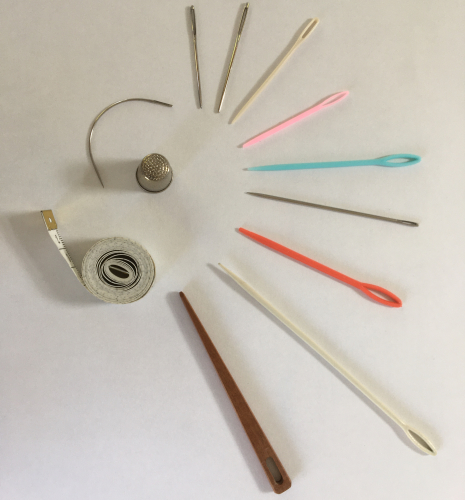 various needles suitable for tapestry weaving
various needles suitable for tapestry weaving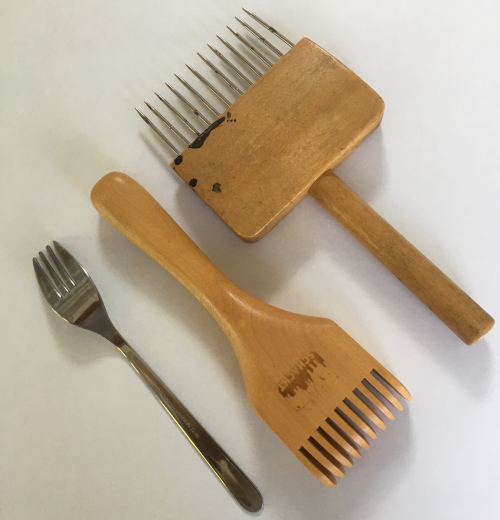 tapestry beaters and a fork
tapestry beaters and a fork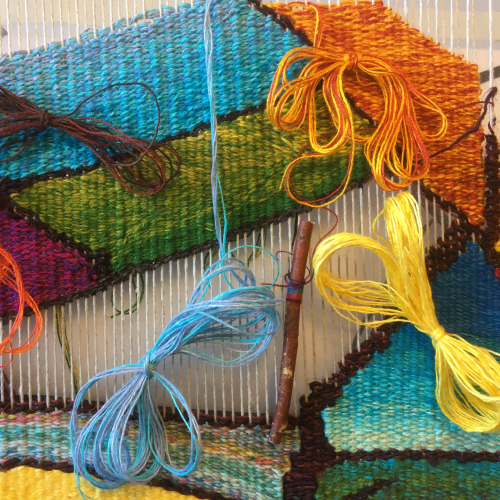 yarn butterflies
yarn butterflies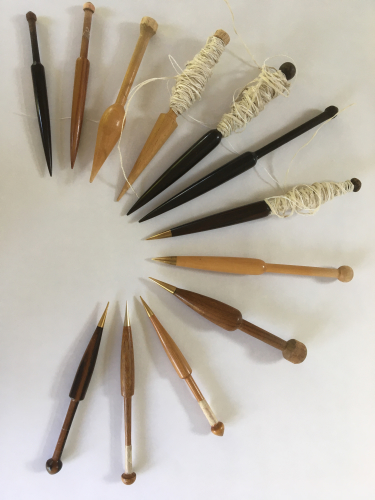 bobbins, some with yarn
bobbins, some with yarn
Posture
How you sit at your tapestry loom is particularly important if you are not to suffer unnecessary aches and pains so here are a few golden rules.
- Keep your working area no higher than mid-chest wherever possible, otherwise you will start to put strain on your back and shoulders. Either move your tapestry down or your chair up – but be aware of your safety: we do not recommend perching on an assortment of chairs and boxes!
- Get up and move frequently – put your basket of yarn out of reach so you have to move to get a new length of warp or set a timer to remind you to get up and walk around.
